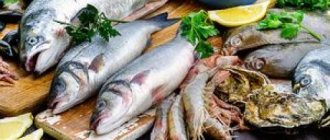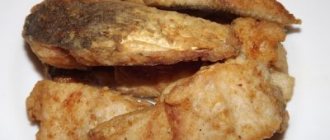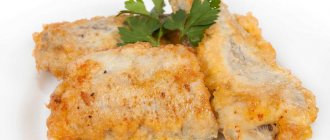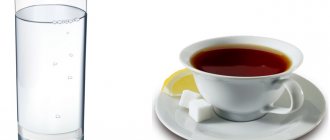What is healthier: pollock or cod?
The cold waters of the Pacific seas are home to a large number of cod fish (about 100 species), and among them there are both “folk” favorites and real exotics. Today we want to talk about what is healthier than pollock or cod, although it is difficult to talk about this, given that the first is widespread, and the “head” of the genus is more expensive, and on the shelves, under any cod fish, the less valuable pollock is often hidden. Most cod, with the exception of freshwater burbot, arrive on the shelves frozen, and it is difficult to tell the difference between a cut carcass, which is what scammers take advantage of.
Which fish is healthier: pollock or cod?
Food entering the human body is not only a source of energy and saturation, but also a medicine in the treatment of various diseases .
It is capable of normalizing, restoring, and giving longevity, provided that the food products are healthy. Fish is just such a healthy food. It must certainly be present in the human diet, because it contains many substances that are important for the functioning of the entire body. Which fish will benefit you the most?
Some of the most worthy examples of marine fauna are pollock and cod. The beneficial properties, composition, nutritional value and calorie content of these fish correspond to the principles of a healthy diet.
Pollock and cod - basic information
They are part of the large cod fish . It also includes hake, burbot haddock, pollock and others.
Pollock is one of the most popular commercial fish found in the Pacific Ocean. It has a rich chemical composition and an affordable price . It has become widespread because of its highly nutritious meat.
Due to its low calorie content in cooking, pollock is used to prepare appetizing and healthy dishes . Flour, minced meat, and delicacies are produced from it. It is good boiled, smoked, stewed, baked and fried.

As a marine fish found in the Northern Hemisphere, cod is distinguished by subspecies: Baltic , Arctic , Pacific , Atlantic . This is a predatory fish with a juicy, soft taste and delicate flesh.
This fish is valuable for its dietary meat and fatty liver. Its pulp is prepared in different ways: boiled, stewed, fried, smoked, baked in the oven. It goes well with other ingredients.
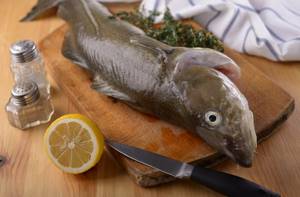
External differences
Before deciding which is better, let's consider each subject individually, and let's start with the last one. There are two main types of navaga: the Far Eastern one, which is the leader in the number of catches, and lives in the Chukchi, Okhotsk and Japan seas, as well as the northern one, which is found in the White, Pechersk and Kara seas. They differ little in size and rarely reach 50 centimeters in length, which cannot be said about its relative. It also lives in the seas of the Pacific Ocean, the body length often exceeds half a meter, and the weight of adult individuals often reaches 20 kilograms. Meanwhile, individuals less than 50 centimeters in length are often caught and end up on the shelves.
By the way, pollock is the most common type of cod, as evidenced by its great popularity. Until recently, it was most often found on the shelves, and therefore it became truly “folk”, but when talking about which is tastier, pollock or navaga, many people give preference to the more tender and juicy meat of the latter. It’s difficult to argue about tastes, but experts also agree with this opinion, and chefs especially welcome the absence of small bones, which formed the basis for the widespread use of fish in the kitchens of restaurants of various levels, including the most prestigious.
The benefits of pollock
- Fish contains a large amount of vitamins and minerals that improve overall well-being and mood, and increase immunity.
- Iodine improves the functioning of the thyroid gland.
- Selenium helps remove toxins and has a positive effect on hair, nails and skin.
- The high potassium content affects the functioning of the heart, strengthening its muscles and blood vessels, and a decrease in swelling is observed.
- Calcium, fluorine and phosphorus are necessary to strengthen bones and tooth enamel. Phosphorus also helps maintain the beauty of nails and hair.
- Vitamin A improves visual acuity, and is especially necessary for the growth and healthy development of a young body.
- B vitamins strengthen the nervous system and improve the functioning of the gastrointestinal tract.
- Thanks to iron, the process of hematopoiesis improves, which is very important for anemia.
- Omega-3 and Omega-6 fatty acids reduce cholesterol levels and stimulate metabolic processes.
- Contains a lot of protein , which has a beneficial effect on brain function and the digestive system, and almost no carbohydrates. It helps athletes strengthen muscles and restore the body's resources after physical exertion.
- Pollock liver and caviar are useful . They are used for medicinal and cosmetic purposes. The liver is a storehouse of vitamin A.

Pollock or navaga
One can argue endlessly about which is tastier, pollock or navaga. But many still prefer navaga. It has more tender and juicy meat. Many chefs also note the absence of small seeds. The benefits of both representatives of the large cod family are difficult to underestimate. It's hard to say which is more useful. Pollock contains more vitamin A than navaga. Both varieties contain sufficient amounts of Omega 3 polyunsaturated fatty acids, which can lower cholesterol levels, which promotes weight loss. It is worth noting that navaga has less calories and is more suitable for organizing dietary nutrition.
The benefits of cod
- It is rich in vitamins and microelements that normalize the functioning of all systems of the human body. Its use strengthens the immune system, reduces the development of seasonal vitamin deficiency, colds and infectious diseases.
- Thanks to the large amount of protein, it is useful for people exposed to heavy physical and mental stress, and athletes.
- This is an easily digestible product that improves the functioning of the digestive system. The phosphorus it contains helps cleanse the body of harmful substances.
- Iodine improves brain activity and blood supply to the brain, and also prevents senile dementia.
- Magnesium, sodium, potassium and healthy fatty acids improve the functioning of the heart and blood vessels. Blood cholesterol levels decrease and blood pressure stabilizes.
- Cod ensures high-quality functioning of the nervous system . It is useful for stress, apathy, increased irritability, neuroses, and insomnia.
- The appearance of the skin, nails and hair structure improves.
- Phosphorus and calcium make bones stronger, strengthen cartilage tissue, and help the body recover faster from fractures.
- Iron helps normalize the hematopoietic system, regulates blood clotting, and prevents the occurrence of anemia.
- Vitamin E and other antioxidants protect body cells from free radicals and reduce the risk of cancer.

Possible contraindications and who should not
The main contraindication is individual intolerance to the components included in the chemical composition of pollock and cod.
Salted and fried pollock, and especially its caviar , is contraindicated for hypertension, stomach ulcers, and kidney disease. People suffering from these diseases should stew or boil it. You should not include cod in your diet if you have kidney problems, gallbladder disease, or hypotension.
Pollock liver is saturated with fat , and this is harmful for gallstone disease. Cod liver is not recommended for people who have an excess of calcium and vitamin D in their bodies.
Composition and benefits
Since we are talking about which is healthier, pollock or cod, we should consider the chemical composition of both representatives of the cod genus. Each of them contains vitamin A, thiamine and other B vitamins in sufficient quantities, including cobalamin and pyridoxine, ascorbic acid, vitamins E, H and PP. The mineral composition is also rich, and all cod varieties contain large amounts of iodine for the thyroid gland, calcium for joints and bones, and phosphorus to improve brain function. Many people today are thinking about extra pounds, so the question of which is better, cod or pollock, for them comes down to which has more calories. Nutritionists assure that both fish have the same calorie content, so they can be safely included in the diet.
What is more useful and for whom?
Pollock and cod are recommended for people who want to lose weight . They contain few calories, fish is easily digested, stimulating the stomach and improving metabolism.
Due to its hypoallergenic nature, pollock fillet is preferable to children from an earlier age than cod fillet. Pollock can be given from 7-8 months , cod from 9-10 months .
Both types are useful for men - to prevent impotence and maintain the health of male organs.
So, pollock and cod are very healthy seafood , rich in vitamins and minerals and having few contraindications.
Selection of fillets
While market experts are preoccupied with trading schemes, how can a buyer know whether the seller is deceiving him? After all, in stores very often they offer us pink salmon under the guise of chum salmon, and trout is passed off as salmon.
Unfortunately, the buyer cannot distinguish one type of fish from another when the fish has already been cut. Of course, there are methods for detecting falsification, for example, protein analysis and DNA analysis are done in special laboratories, but these are expensive examinations for professionals.
You and I can only rely on the appearance and smell of the fish. That is, you need to pay attention to the location and shape of the fins, the presence of scales, the shape of the head and jaws - and all these signs do not work when you choose fillets.
Expert opinion
Svetlana Chebarova, Quality Director of the Quality Control Department of X5 Retail Group : “Even an expert with many years of experience cannot identify fish without skin. In this case, all that remains is to resort to laboratory methods for detecting adulteration of fish. Therefore, you need to buy fish in trusted places that you trust, and also educate yourself so as not to be deceived; for this there are information resources, for example, the “What is what” website, which was created by the Union of Consumer Market Participants (SUPR) to inform consumers about properties of goods".
How to properly cook pollock fillet | Healthy eating
Posted by Serena Styles Updated December 17, 2021
Pollock is a white fish with a strong fishy taste and smell. It is an inexpensive and versatile alternative to other white meats such as tilapia, cod and haddock. One 1-ounce serving of fillet contains 78 calories, 17 grams of protein and less than 1 gram of fat. Pollock fillets flake easily and are usually cooked with oil or fat to keep the meat from falling apart. However, you can cook pollock fillets without adding extra fat and keep them healthy.
Bake
The flaky texture of pollock is particularly suitable for breading. Baking breaded pollock eliminates the need to use fatty, high-calorie oil. With only 17 calories, egg white makes a simple, low-calorie breadcrumb glue. Use plain, fresh breadcrumbs; commercial varieties often have excess sodium. Simple seasonings such as ground black pepper and paprika are ideal for adding flavor to the breading. Either dredge the pollock fillets whole, or grind them and form into balls first. Lining the baking sheet with parchment prevents sticking and helps ensure a crispy crust.
For a couple
For moist, tender pollock with the natural fishy flavor intact, choose steaming. Steamed pollock requires no oil to prevent sticking and works best with light seasonings. Fresh herbs such as cilantro and parsley placed on top of the fillets before steaming will add a subtle flavor. Fresh lemon or lime juice also complements the flavor of the fish. Pollock is steamed when it is flaky and opaque. If you steam them beyond this point, the fillets may fall apart.
Poach
For an easy one-pan meal, cook pollock fillets in a flavorful basting sauce. This method uses a pan of low-sodium chicken, vegetable, or fish broth to coat the fillets about halfway. Fresh herbs and citrus juice flavor the broth without adding calories or sodium. Adding the fillets to the simmering sauce prevents them from sticking and eliminates the need for vegetable oil. When the pollock is cooked, the sauce keeps the meat moist and adds flavor to side dishes served with the fillets.
Roast
For crispy pollock fillets with a fried fish-like texture, use roasted potatoes; Grill grates can cause the tender pollock meat to fall apart. A thin layer of olive oil on the baking sheet prevents the fillets from sticking. Olive oil contains 40 calories and 5 grams of fat per teaspoon, so use it sparingly. A light seasoning mixture of paprika, garlic powder, onion powder, ground black pepper or lemon pepper adds flavor to the fish. Herbs and thick layers of seasonings burn in the Dutch oven. Either fry just one side of the pollock until it's crispy, or flip it halfway through to get crispy on both sides.
.
Whole fish selection
Of course, fillet is very convenient. Throw it in a frying pan and a hot dish for dinner is ready in 15 minutes; you can even cook it without defrosting. But it’s too difficult to buy a truly high-quality product, especially if we remember that fillets are often sold in an icy “glaze,” which can greatly increase its price.
It’s also not easy with frozen fish: it can be frozen, it can thaw and freeze again - and turn into a hard, inedible substance. It can be sold encased in ice or treated with chemicals.
Although a whole frozen carcass is still easier to “bite through”. After all, we can rely on the appearance of the fish, and distinguishing pollock from cod is much easier.
When purchasing chilled products, it is important to pay attention to the smell of the fish, the condition of its skin, the color of the fins and gills. It happens that the gills are removed from chilled fish - it is better not to take such fish, since it is by the gills that it is easy to determine freshness. They should be bright red in color, and only sturgeon (sterlet, beluga, sturgeon, etc.) have dark gills with a reddish tint. If you see gills that are grayish, brown, yellow, covered with spots or mucus, it means that the fish has been traveling around the shelves for a long time or has been poorly stored; in pond fish, such gills can be a sign of illness.
Svetlana Chebarova advises to always carefully inspect the fish, paying attention to every little detail. One of the most significant is the appearance of the fins; they should not be damaged. The scales on the fish should be intact, although there are exceptions, for example, during the fishing process, herring and mackerel lose almost all their scales. When choosing fish, it is best to rely not only on the eyes and nose, you need to touch the fish: in fresh fish, the mucus on the skin is clear and transparent, if the skin has changed color, becoming unnaturally yellow or gray, faded, if it sticks to your hands, it means it is fresh fish should have serious doubts.
When you buy steaks or just chopped fish carcass, look at the meat. It should be without blood clots and without vessels, and its consistency should be dense and elastic.
Signs of a good fish:
- The fish smells of sea freshness
- There is no external damage, the scales are preserved, the fins are intact
- Mucus on the skin is clear and not sticky
- The gills are bright red, without spots
- The meat is dense and elastic, without blood clots
Cod from a chain store turned out to be an unknown animal
Our reader Nina Gordenko contacted the editorial office of KP. A Muscovite, no less, said that a large chain store is cheating its customers. After all, under the guise of frozen cod, there is a completely different fish in the refrigerators!
“I now live in the capital, but I spent my childhood and youth in Vladivostok,” the woman said. – My father worked on a fishing trawler. I can unmistakably distinguish the taste of any popular fish. Previously, due to poverty, the family only ate this, dad brought food from the service. I recently bought packaged cod steaks at the store. My suspicions arose when I opened the package - somehow the fish looked wrong. The meat is too dark. I fried the cod and the taste was also not the same. Looks more like saithe.
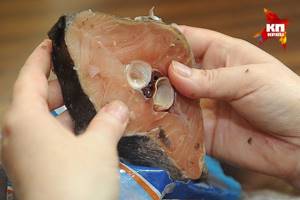
For a cod steak, the meat is too dark, don’t you think? Photo: Vladimir VELENGURIN
The next day, the Muscovite went back to the store and asked the administrator for documents for the goods. But she was told that there were no papers. And they sent us to the company’s head office to get the certificates.
Be careful, fish fillets: how not to be deceived when buying

In Germany, almost a third of the fish tested did not live up to their name on the label. A similar situation has developed in England, where cod and haddock are often replaced by pollock, pangasius and catfish, much cheaper varieties of fish.
Similar substitutions, alas, are observed in Russia. Rosselkhoznadzor also identifies cases of falsification during product inspections in stores. It is especially popular to replace cod fillet with cheaper pollock fillet.
Specialists from Rosselkhoznadzor, together with participants in the fish market, are trying to create a transparent, and most importantly controlled at every stage, system for the supply of fish to Russia, as well as a system of control over their own, Russian producers and suppliers. After all, the danger of such falsifications is not only that the consumer will buy products whose real cost is 2-3 times lower, but also that the falsified fish does not undergo proper veterinary and sanitary examination and may not be safe for the health of buyers.
Taste qualities
Connoisseurs of tasty and healthy food know that the Japanese know a lot about food and understand healthy products. Speaking about which is tastier, cod or pollock, suffice it to say that the latter is very popular in Japanese and Chinese cuisine, and they definitely have taste. Thus, we can draw a simple conclusion as to which is better, because oriental chefs are unlikely to use second-rate fish to prepare their delicious dishes. It was the taste qualities that caused the population of this accessible fish to sharply decrease, which led to its partial disappearance.
The meat of these cod, however, is difficult to distinguish, especially when cooked, although real chefs know what to emphasize. It should be noted, however, that pollock meat pleases us with its taste all year round - it is always tender, with a pleasant fishy smell. As for the second test subject, fish caught in the fall, when fish spawning begins, tastes better. Cod liver is very popular, and it is in it that most of the fat and nutrients are concentrated, but pollock caviar turned out to be no less useful, because it is not for nothing that it is used to make fish oil.
Selection of fillets
While market experts are preoccupied with trading schemes, how can a buyer know whether the seller is deceiving him? After all, in stores very often they offer us pink salmon under the guise of chum salmon, and trout is passed off as salmon.
Unfortunately, the buyer cannot distinguish one type of fish from another when the fish has already been cut. Of course, there are methods for detecting falsification, for example, protein analysis and DNA analysis are done in special laboratories, but these are expensive examinations for professionals.
You and I can only rely on the appearance and smell of the fish. That is, you need to pay attention to the location and shape of the fins, the presence of scales, the shape of the head and jaws - and all these signs do not work when you choose fillets.
Expert opinion
Svetlana Chebarova, Quality Director of the Quality Control Department of X5 Retail Group : “Even an expert with many years of experience cannot identify fish without skin. In this case, all that remains is to resort to laboratory methods for detecting adulteration of fish. Therefore, you need to buy fish in trusted places that you trust, and also educate yourself so as not to be deceived; for this there are information resources, for example, the “What is what” website, which was created by the Union of Consumer Market Participants (SUPR) to inform consumers about properties of goods".
External differences and similarities
If frozen cod pieces look practically the same, then there are some differences in appearance, although this does not affect the question of which is better, of course. The first is indicated by a bright stripe on the side along the entire body, although both representatives of cod have spots on their bodies, as well as the same number of fins - three dorsal and two anal. And even a mustache on the chin is present in both subjects. Adults also have different sizes - pollock reaches a length of 80 centimeters, while the second test subject grows up to two meters. She also lives about twice as long. The only obvious difference is that the latter has a more rounded shape.

